This article was co-authored by Natalie Punt, DVM. Dr. Natalie Punt is a Veterinarian and the Founder and CEO of mPet- a smart phone app for pet owners to store, manage and transfer their pets medical records and health information. She specializes in small animal emergency and general medicine and veterinary practice economics. Dr. Punt holds a BS in Biochemistry and Molecular Biology from The University of California, Davis, an MS in Biochemistry from The University at Buffalo, and a DVM from Western University of Health Sciences.
There are 11 references cited in this article, which can be found at the bottom of the page.
wikiHow marks an article as reader-approved once it receives enough positive feedback. In this case, 100% of readers who voted found the article helpful, earning it our reader-approved status.
This article has been viewed 903,196 times.
Did you know you can approximate your dog's age by examining its teeth? In adult dogs, examining the teeth will give you a very rough estimate of the dog's age. In puppies, the age can be estimated with a bit more accuracy because puppies usually shed their baby teeth at a predetermined age.[1] While the teeth will only give you a very rough estimate of the dog's age, it's a good starting point.
Steps
Understanding Your Dog’s Teeth
-
1Understand the structure and organization of your dog's teeth. All dogs have four basic types of teeth: incisors, canines, premolars, and molars. These are found on the upper and low jaws, on both the left and right sides.[2]
- The incisors are the small teeth running along the front of the mouth. Adult dogs have six incisors on the top and six on the bottom jaw. The two side incisors (next to the canine teeth) are a bit bigger than the middle incisors; on the top these also tend to stick out to the side a bit more.
- The canine teeth are located behind the incisors, one on each side for a total of four. These are the large, pointed teeth.
- Premolars come in behind the canines. There are four premolars both on the upper and lower jaw. The fourth premolar on the top is very large.
- Finally behind the premolars are the molars. On the top of your dog's mouth there are two molars. On the bottom jaw there are three molars. The first one is larger than the other two.
-
2Understand how your dog's teeth grow in. Puppies generally have around 28 teeth. For the first two to four weeks, there are no noticeable teeth. Baby canines start coming in after three to four weeks. Baby incisors and premolars start after four to six weeks. By eight weeks, all baby teeth are grown in. For the next three months, there will be no noticeable changes.[3]
- After three to five months, permanent teeth will start coming in, usually canines and molars first. By seven months, all permanent teeth will have grown in. If your puppy has all of its permanent teeth, then it is most likely more than 7 months old. Adult dogs will have around 42 teeth.[4]
- After the puppy stage, age is marked by tooth wear. At one year, teeth are white and clean. By the end of the second year, the white will have dulled and tartar will begin building up. This will cause yellowing on the back teeth. After three to five years the yellowing will increase and be visible on all teeth. There will be noticeable tooth wear.[5]
Advertisement -
3Understand how and why dog teeth wear down and decay. Tooth wear is a natural occurrence, but it can be accelerated by certain habits such as aggressively chewing on hard objects (bones, rocks, sticks) or in small dog’s without good dental care. On the other hand, some chewing is great for a dog’s dental health. Rawhides or “dental” chews can help dogs break down plaque and material on the teeth.[6]
- Also understand how disease manifests. By age three, nearly 80% of dogs will exhibit signs of gum disease. This can be seen in the buildup of yellow and brown tartar, inflamed gums, and bad breath. Gum disease is more prevalent in small dog breeds.[7]
- Food also plays a role in dog dental health. Dry food in strong chewers can help remove some plaque from the teeth slowing tooth decay and loss. There are specially formulated foods specifically for dental health. Your veterinarian can advise you on the proper diet for your dog if you are worried about its teeth. Water additives can also be used to combat teeth destroying and aging bacteria.[8]
- Worn teeth can look fractured, though regular wear poses little health risk. Excessive wear can damage the root of the tooth, which can require a root canal.
Estimating Your Dog’s Age
-
1Evaluate a puppy's age by assessing its tooth growth. Teeth grow fast at the early puppy stage. Because the change is so rapid, this is the most accurate time to be able to tell a dog's age. Count the type and position of your puppy's teeth to estimate their age.[9]
- Newborn puppies are born without their teeth erupted from the gums. At certain intervals teeth will erupt. The first baby teeth to appear will generally be the canine teeth at 3-4 weeks of age. At 4-5 weeks of age the two middle incisors erupt. At 4-6 weeks the first two molars erupt. At 5-6 weeks the third incisors erupt. And at 6-8 weeks of age the third molar erupts. The premolars do not appear until much later.
- At eight weeks and older puppies will have 28 baby teeth. At around 4 months of age the puppy will begin to lose its baby teeth as the adult teeth will erupt. Most times, puppies swallow these teeth but occasionally the owner will find a shed baby tooth or see the gum line is bleeding where a tooth has erupted. Just as with baby humans, puppies at this stage will love to chew on things!
- At 4-5 months the adult incisors, first premolar, and first molar will erupt.[10] At 5-6 months the adult canine, premolars 2-4, and second molars erupt. Finally, at 6-7 months the adult third molar will erupt. All together there will be 42 adult teeth.
-
2Evaluate the condition of your adult dog's teeth to estimate its age. In the first two years of adult life, the teeth are generally white with very little wear. By the end of the second year the white will have dulled and tartar will begin building up. This will cause yellowing on the back teeth. Eventually wear and tear and accumulation of plaque and bacteria will begin to age the teeth. This is how we estimate an adult dog’s age.[11]
- By age three, most dogs will have some signs of tooth disease: accumulation of yellow and brown tartar, reddened gums, bad breath. Of course, dogs with owners who brush their teeth daily and who take their dog to the dog dentist regularly will not have these signs of wear and tear and disease.
- After three to five years the yellowing will increase and be visible on all teeth. There will be noticeable tooth wear. As the dog ages, teeth will continue to show increased wear. The gums may recede from the teeth leaving roots exposed which may lead to tooth loss. The teeth staining will become more pronounced turning the yellow to brown color.
- From 5 to 10 years, teeth will continue to show increased wear. Signs of disease will likely appear. By 10 to 15 years, some teeth may be missing and decay will be widespread.
-
3Consult your vet if you would like a more accurate estimation of your dog's age. All told, it can be difficult to determine a dog’s age by merely looking at it’s teeth. Food, habits, dental care (or lack of it) can all play a role in hastening or slowing teeth wear in all dogs.
Expert Q&A
Did you know you can get expert answers for this article?
Unlock expert answers by supporting wikiHow
-
QuestionHow can I tell if sharp teeth are puppy or adult teeth?
 Pippa Elliott, MRCVSDr. Elliott, BVMS, MRCVS is a veterinarian with over 30 years of experience in veterinary surgery and companion animal practice. She graduated from the University of Glasgow in 1987 with a degree in veterinary medicine and surgery. She has worked at the same animal clinic in her hometown for over 20 years.
Pippa Elliott, MRCVSDr. Elliott, BVMS, MRCVS is a veterinarian with over 30 years of experience in veterinary surgery and companion animal practice. She graduated from the University of Glasgow in 1987 with a degree in veterinary medicine and surgery. She has worked at the same animal clinic in her hometown for over 20 years.
Veterinarian Puppy teeth are much smaller than adult teeth, and literally more needle-like. There are more likely to be gaps between the milk teeth as the dog is growing and so the teeth spread out. The crowns are often bright white, and semi-translucent with a hint of pink beneath the enamel. This is because the teeth are so small you can glimpse the living pulp through the crown. Adult teeth are generally more chunky and rounded, and the enamel starts out white but often ages to a creamy color.
Puppy teeth are much smaller than adult teeth, and literally more needle-like. There are more likely to be gaps between the milk teeth as the dog is growing and so the teeth spread out. The crowns are often bright white, and semi-translucent with a hint of pink beneath the enamel. This is because the teeth are so small you can glimpse the living pulp through the crown. Adult teeth are generally more chunky and rounded, and the enamel starts out white but often ages to a creamy color. -
QuestionWhen do a puppy's testicles drop into the scrotum?
 Pippa Elliott, MRCVSDr. Elliott, BVMS, MRCVS is a veterinarian with over 30 years of experience in veterinary surgery and companion animal practice. She graduated from the University of Glasgow in 1987 with a degree in veterinary medicine and surgery. She has worked at the same animal clinic in her hometown for over 20 years.
Pippa Elliott, MRCVSDr. Elliott, BVMS, MRCVS is a veterinarian with over 30 years of experience in veterinary surgery and companion animal practice. She graduated from the University of Glasgow in 1987 with a degree in veterinary medicine and surgery. She has worked at the same animal clinic in her hometown for over 20 years.
Veterinarian The testicles can be present in the scrotum from just a few week's old, although they can be difficult to feel at this young age. For other dogs the testicle take weeks or months to drop, but they should be present by six-month's of age. If by this age they have not descended then it's unlikely it will happen, although it is worth waiting an additional three months on the off-chance.
The testicles can be present in the scrotum from just a few week's old, although they can be difficult to feel at this young age. For other dogs the testicle take weeks or months to drop, but they should be present by six-month's of age. If by this age they have not descended then it's unlikely it will happen, although it is worth waiting an additional three months on the off-chance.
Warnings
- Dogs don’t always like having their teeth examined. Always be cautious putting your hand near a dog’s mouth and never place your hands in a strange or unknown dog's mouth.⧼thumbs_response⧽
- A good dog owner will not neglect the dog’s teeth to the point that the teeth are missing (which indicates cavities and abscesses) or that the gums bleed. This is painful and neglectful on the part of the owner.[12]⧼thumbs_response⧽
Expert Interview
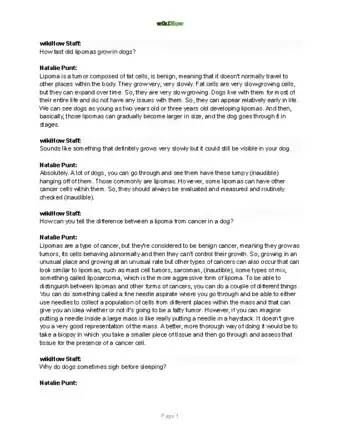
Thanks for reading our article! If you'd like to learn more about dogs, check out our in-depth interview with Natalie Punt, DVM.
References
- ↑ Kirk and Bistner’s Handbook of Veterinary Procedures and Emergency Treatment. Ford and Mazzaferro. Elsevier.
- ↑ https://dogappy.com/understanding-dental-anatomy-of-dogs
- ↑ https://www.petmd.com/dog/care/puppy-teeth-everything-you-need-know
- ↑ http://www.canismajor.com/dog/teeth.html
- ↑ http://www.ruralareavet.org/PDF/Physical_Exam-How_to_Determine_Age.pdf
- ↑ https://pets.webmd.com/dogs/features/dogs-teeth-toothaches-problems#1
- ↑ https://pets.webmd.com/dogs/features/perlis-gum-disease-dogs#1
- ↑ https://www.petmd.com/dog/grooming/evr_dg_oral_hygiene_and_your_dogs_health?page=2
- ↑ https://www.petmd.com/dog/care/puppy-teeth-everything-you-need-know
About This Article
If your puppy is starting to get teeth, it's probably between 3 and 4 weeks old. At 8 weeks of age, your puppy will have 28 baby teeth. For an adult dog, expect 1 or 2-year-olds to have white teeth, while 3-year-olds may have signs of tooth decay, such as yellow and brown tartar. If your dog has increased signs of wear and disease, it's likely between 5 and 10 years of age, while it will be between 10 and 15 if some teeth are missing and decay is widespread. For tips on identifying the different types of dog teeth, keep reading!

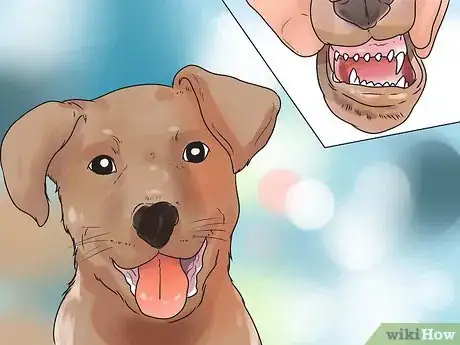
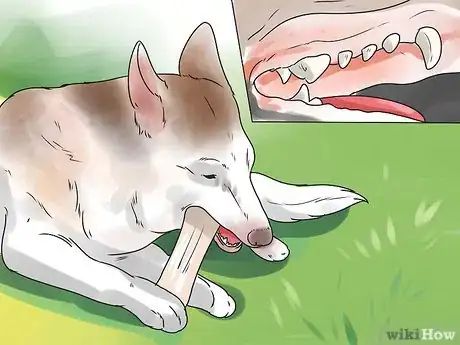
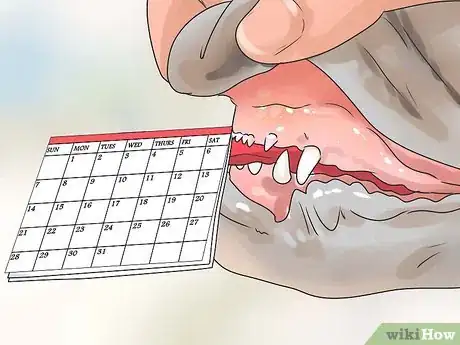

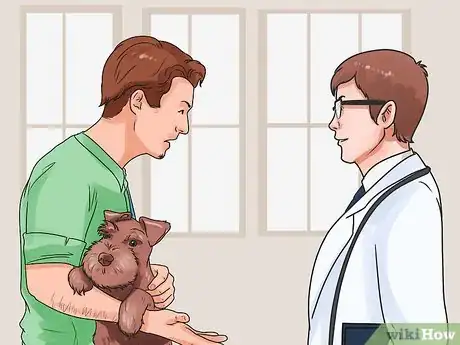

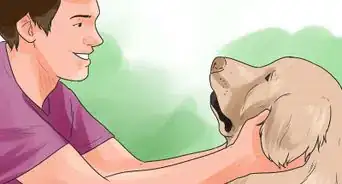

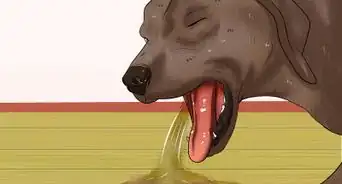






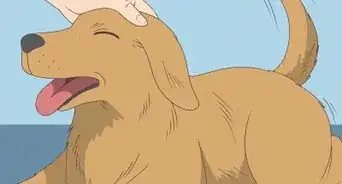
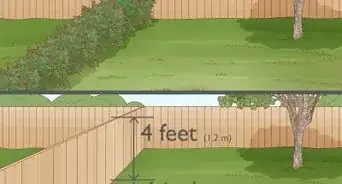
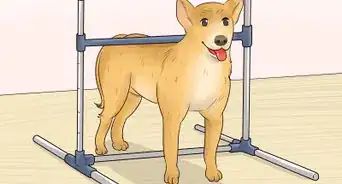
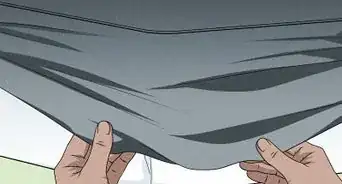
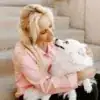











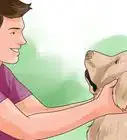
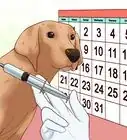
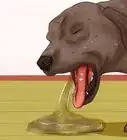



































Medical Disclaimer
The content of this article is not intended to be a substitute for professional medical advice, examination, diagnosis, or treatment. You should always contact your doctor or other qualified healthcare professional before starting, changing, or stopping any kind of health treatment.
Read More...